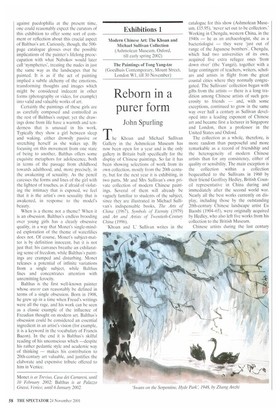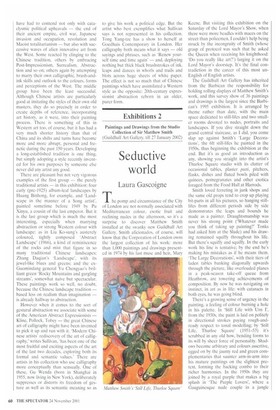Modern Chinese Art: The Khoan and Michael Sullivan Collection (Ashmolean Museum, Oxford, till early spring 2002)
The Paintings of Tong Yang-tze (Goedhuis Contemporary, Mount Street, London Wl, till 30 November)
Reborn in a purer form
John Spurling
The Khoan and Michael Sullivan Gallery in the Ashrnolean Museum has now been open for a year and is the only gallery in Britain built specifically for the display of Chinese paintings. So far it has been showing selections of work from its own collection, mostly from the 20th century, but for the next year it is exhibiting, in two parts, Mr and Mrs Sullivan's own private collection of modern Chinese paintings. Several of them will already be vaguely familiar to students of the subject, since they are illustrated in Michael Sullivan's indispensable books, The Arts of China (1967). Symbols of Eternity (1979) and Art and Artists of Twentieth-Century China (1996).
'Khoan and T.' Sullivan writes in the catalogue for this show (Ashmolean Museum, £15.95), 'never set out to be collectors.' Working in Chengdu, western China, in the 1940s — he as an archaeologist, she as a bacteriologist — they were 'just out of range of the Japanese bombers'. Chengdu, which had two universities of its own, acquired five extra refugee ones 'from down river' (the Yangzi), together with a large contingent of teachers, writers, scholars and artists in flight from the great coastal cities where they normally congregated. The Sullivans' collection began with gifts from the artists — there is a long tradition among Chinese artists of such generosity to friends — and, with some exceptions, continued to grow in the same way over half a century as Sullivan developed into a leading exponent of Chinese art and became first a lecturer in Singapore and London, then a professor in the United States and Oxford.
The collection as a whole, therefore, is more random than purposeful and more remarkable as a record of friendship and the heterogeneity of modern Chinese artists than for any consistency, either of quality or sensibility. The main exception is the collection within a collection bequeathed to the Sullivans in 1960 by their friend Geoffrey Hedley, British Council representative in China during and immediately after the second world war. Nearly all the best works currently on display, including those by the outstanding 20th-century Chinese landscape artist Lu Baoshi (1904-65), were originally acquired by Hedley, who also left five works from his collection to the British Museum.
Chinese artists during the last century have had to contend not only with cata clysmic political upheavals the end of their ancient empire, civil war, Japanese invasion and occupation, revolution and Maoist totalitarianism — but also with successive waves of alien innovative art from the West. Some reacted by clinging to the Chinese tradition, others by embracing Post-Impressionism, Surrealism, Abstraction and so on; others again by attempting to marry their own calligraphic, brush-andink skills and outlook to the colours, forms and perceptions of the West. The middle group have been the least successful. Although Chinese artists are particularly good at imitating the styles of their own old masters, they do so precisely in order to create depths of reference, incorporating art history, as it were, into their painting process. There is something of this in Western art too, of course, but it has had a very much shorter history than that of China and its shifts and turns have become more and more abrupt, personal and frenetic during the past 150 years. Developing a long-established tradition is one thing, but simply adopting a style recently invented for his own purposes by someone else never did any artist any good.
There are pleasant but not very vigorous
examples of the first group the purely traditional artists — in this exhibition: four early (pre-1925) album-leaf landscapes by Huang Binhong, for example, and 'Landscape in the manner of a Song artist', painted sometime before 1949 by Pu Xinyu, a cousin of the last emperor. But it is the last group which is much the most interesting, especially when marrying abstraction or strong Western colour with landscape: as in Liu Ko-sung's austerely coloured, tightly composed 'Abstract Landscape' (1966), a kind of reminiscence of the rocks and mist that figure in so many traditional Chinese landscapes; Zhang Daqian's 'Landscape', with its jewel-like blues and greens; and the exGuomindang general Yu Chengyao's brilliant green 'Rocky Mountains and gurgling streams', somewhat naive but spectacular. These paintings work so well, no doubt, because the Chinese landscape tradition — based less on realism than imagination — is already halfway to abstraction.
However when it comes to the sort of gestural abstraction we associate with some of the American Abstract Expressionists — Kline, Pollock, Tobey — the great Chinese art of calligraphy might have been invented to pick it up and run with it. 'Modern Chinese artists' rediscovery of the art of calligraphy,' writes Sullivan, 'has been one of the most fruitful and exciting aspects of the art of the last two decades, exploring both its formal and semantic values.' There arc artists in his collection who use calligraphy more conceptually than sensually. One of these, Gu Wenda (born in Shanghai in 1955, now living in New York), deliberately suppresses or distorts its freedom of gesture as well as its semantic meaning so as to give his work a political edge. But the artist who hest exemplifies what Sullivan says is not represented in his collection. Tong Yang-tie has a show to herself at Goedhuis Contemporary in London. Her calligraphy both means what it says — old sayings and phrases, such as 'Renew yourself time and time again' — and, deploying nothing but thick black brushstrokes of ink, leaps and dances in whorls and trails and blots across huge sheets of white paper. The effect is not so much that of Chinese paintings which have assimilated a Western style as the opposite: 20th-century expressionist abstraction reborn in an older, purer form.



















































































 Previous page
Previous page